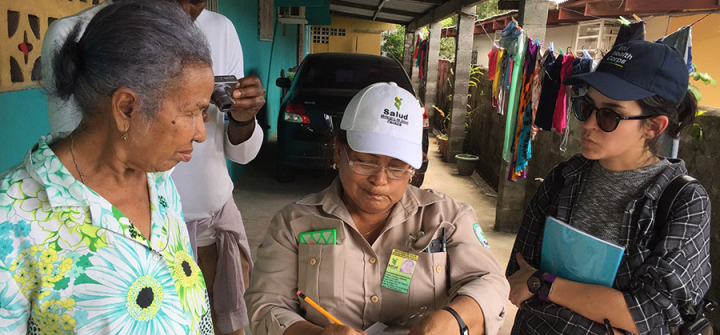Lifesaving Tech Support
In Panama, a vector technician named Orlando goes from house to house, street to street, gathering and tracking data about mosquito breeding sites and disease hot spots.
It’s a difficult job. His success depends on his interpersonal skills, on earning the trust of residents, providing effective education and gaining access to property to pinpoint and assess where mosquitoes breed.
Until this year, Panamanian technicians like Orlando used pen and paper to collect and tabulate information about vectorborne diseases like Zika. It could take up to a week for this data to make its way to central decision makers. By then, untold infections may have occurred.
Around the world, information technology can make a life-or-death difference for communities facing urgent public health challenges. By making it easier to collaborate and analyze data, communities have a powerful tool for improving health—especially when accompanied by sound public policy and collaboration among the public, private and nonprofit sectors.
The key is to apply technology wisely—taking into account the people who will use or benefit from the technology: policymakers, stakeholders, health care workers and the communities themselves.
It's also all too easy for well-meaning outsiders to misread public health challenges in regions where access to effective health care and outcomes are inconsistent. For example, some think that technology is a panacea. Conversely, others may claim that social, political, cultural, economic or environmental challenges need to be solved before introducing technology.
The reality is more nuanced and complicated. For instance, it may be enough that the introduction of technology will spur efforts to fix societal dysfunction. Further, outside groups providing assistance should strongly consider partnering with local organizations with the credibility to help change the status quo.
This has been our experience with IBM Health Corps, a global, pro bono consulting program that addresses health issues. In the case of Panama, we partnered with the country’s prestigious Gorgas Memorial Institute of Health Studies to modernize its data collection approach to managing vectorborne diseases.
Working with Gorgas, vector technicians like Orlando, and public health officials, we created a mobile app to collect timely data in the field. Not surprisingly, some of the field inspectors feared the app would make their role obsolete. Taking their concerns to heart, the team took pains to ensure that the app would empower the health workforce and decision makers. The software, which will go live this spring, enables field workers to spend more time educating the community and less time bogged down in the mechanics of reporting.
In the UK, technology helped shaped Calderdale’s response to a human-caused public health problem: shortened lifespans due to sedentary lifestyles. IBM used analytics technology to identify common patterns in notes recorded by social service workers—pinpointing concentrations of foster youth and senior citizens with fewer options for physical activity. With these insights, Calderdale created more exercise opportunities tailored to appeal to these groups.
Other communities are also turning to technology as a component of a bigger, multi-tiered strategy. For instance, in sub-Saharan Africa, new cancer cases and cancer deaths are expected to double by 2030. Until now, reliable chemotherapy medicines have been expensive or hard to obtain because countries had trouble predicting their medication needs to buy in the quantities required to benefit from volume pricing discounts.
In response, IBM Health Corps experts designed software to help planners and procurement personnel at health ministries make more precise chemotherapy forecasts, check medicine inventories, pinpoint available suppliers, determine costs, and place chemotherapy orders with enough advance notice to qualify for and guarantee volume pricing discounts.
Note that technology itself was not the end goal here; it enabled other fundamental reforms in community health. Partnerships formed with organizations that enjoy local credibility and respect proved key.
Technology itself can't magically change facts on the ground. It is a means to an end, and local, human talent still needs to be a focus. But technology, applied in concert with other efforts—such as social service and public policy reforms, better collaboration among bureaucracies, and a greater emphasis on prevention and prediction—can help accelerate positive reform that will lead to better health and a better quality of life for all, not just the fortunate few.
Jennifer Ryan Crozier is president of the IBM Foundation and spearheaded the establishment of IBM Health Corps.
Ed. Note: IBM Health Corps is accepting proposals for data, technology and program design initiatives that can address strengthening the health workforce and heath disparities in cancer prevention and care. Organizations can learn more about the application process and apply here.
Join the tens of thousands of subscribers who rely on Global Health NOW summaries and exclusive articles for the latest public health news. Sign up for our free weekday enewsletter, and please share the link with friends and colleagues: http://www.globalhealthnow.org/subscribe.html
An IBM Health Corps team member (right) evaluating the manual data collection process of a Panama Health Department field worker as she interacts with citizens. Image Courtesy of IBM Health Corps




